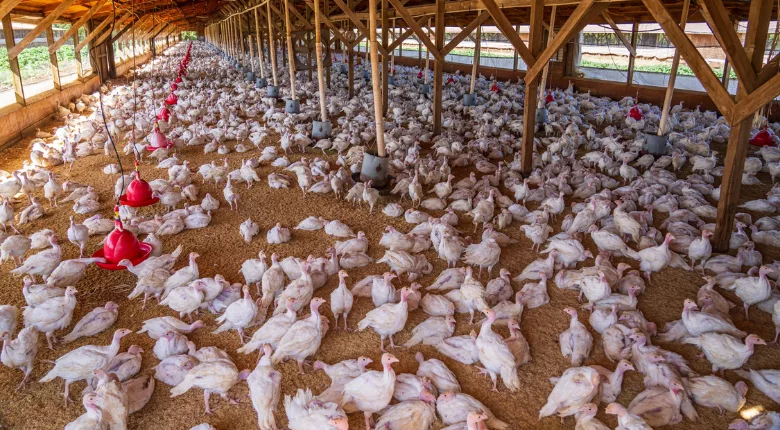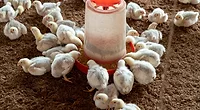Multi-Hurdle Approach Crucial to Controlling Salmonella in Poultry, Reports FAO/WHO

Image credit: Mark Stebnicki via Pexels
There is no one control measure that is sufficiently effective in reducing Salmonella in poultry; instead, a multi-hurdle approach is proven to have the greatest impact, according to a recent report from the Joint Food and Agriculture Organization of the United Nations (FAO)/World Health Organization (WHO) Expert Meetings on Microbiological Risk Assessment (JEMRA).
In response to a request from the 52nd Session of the Codex Alimentarius Commission Committee on Food Hygiene (CCFH), JEMRA met in September 2022 to assess the most recent science on the control of non-typhoidal Salmonella in chicken meat, as well as to review the Codex Guidelines for the Control of Campylobacter and Salmonella in Chicken Meat (CXG 78-2011). JEMRA considered available literature published since 2008 and information submitted in response to a call for data. However, many control measures for Salmonella in the broiler production chain lacked sufficient evidence to assess their efficacy. JEMRA drew conclusions about control measures, for which there were a sufficient number of reports with quality and applicable data, from primary production to processing and post-processing.
The experts also highlighted factors that may impact Salmonella control strategies in the future, such as changes in climate, human behavior and awareness, and interactions between pathogens and their hosts; innovations in the broiler supply chain; and improvements in food safety culture. Next-generation technologies and methods, including machine learning, omics, traceability tools, and microbiome science, could lead to improved quantitative microbial risk assessments and a better One Health outlook.
Primary Production Controls
For primary broiler production, JEMRA found the most important and promising strategies for Salmonella control to be biosecurity and management approaches—such as sanitation, hygiene, and flocks beginning Salmonella-free at the parent/grandparent level—and competitive exclusion/probiotic approaches. However, more studies are needed on competitive exclusion using naturally contaminated chicks or under commercial conditions. Vaccine-based strategies were also proven to reduce the prevalence and shedding of Salmonella in flocks, but do not eliminate the pathogen.
Feed and water characteristics and management approaches showed variable efficacy dependent on the physiological status of both the pathogen and the animal, the broiler gastrointestinal tract environment, feed/water additive concentration, and the method for the additive’s application. Although feed modifications, including acidification of feed and water, are not sufficient control measures on their own, feed-based strategies can be helpful in reducing Salmonella when used in conjunction with good hygiene practices (GHPs). More research is required to assess how wide-scale application of modified feed and management approaches could impact Salmonella levels.
The use of antimicrobial food/water additives showed no strong evidence for effective Salmonella control. Finally, there is limited information on the efficacy of bacteriophage-based approaches, and more research is needed, especially long-term studies.
Looking for quick answers on food safety topics?
Try Ask FSM, our new smart AI search tool.
Ask FSM →
Processing and Post-Processing Interventions
Just as in primary production, GHPs are a crucial strategy for minimizing the risk of Salmonella contamination during slaughter and processing.
The effect of processing interventions on Salmonella is influenced by a variety of conditions, such as the characteristics of the Salmonella strain, pH levels, agent concentration, temperature, contact time, absorbed dose, product characteristics, and processing parameters. High-pressure processing (HPP) was proven effective in reducing Salmonella in poultry meat, and there was extensive evidence for the efficacy of ionizing radiation in achieving any level of Salmonella reduction, from pasteurization to complete sterility.
Regarding the use of water additives, chlorine-based compounds and organic acids like lactic acid, peracetic acid (PAA), and acified chlorate showed potential efficacy. There was insufficient evidence to draw conclusions on other water additives.
Other interventions or combinations of interventions (e.g., novel additives, thermal processing, and physical treatments applied to meat) still require further refinement.
Regarding post-processing interventions, JEMRA placed the most emphasis on encouraging a positive food safety culture when it comes to transport, storage handling, and cooking practices. While control measures applied during processing could extend shelf life and control the growth of Salmonella at the retail or consumer levels, very little literature exists in this area, and post-processing interventions need further study.






.webp?height=200&t=1691503719&width=200)


